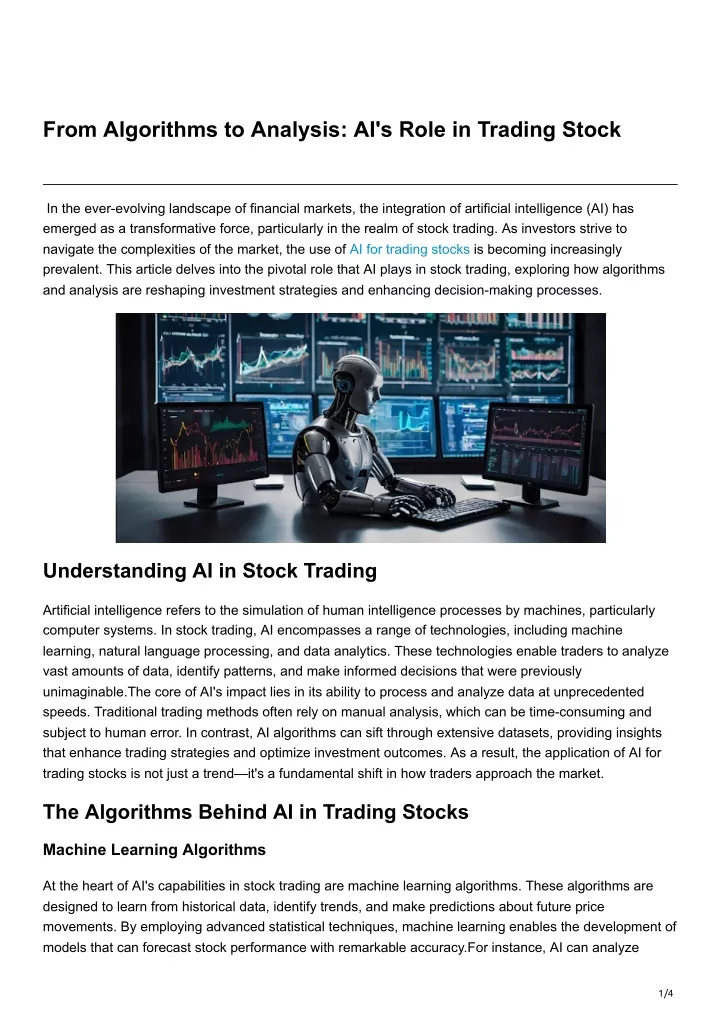20 Recommended Advice To Selecting AI Stock Investing Analysis Sites
20 Recommended Advice To Selecting AI Stock Investing Analysis Sites
Blog Article
Top 10 Ways To Evaluate The Market Coverage Offered By Ai Trading Platforms That Predict/Analyze Stocks.
The market coverage of the trading platforms that use AI analysis of stocks is vital, since it defines the assets and markets that you are able to access. With a platform that provides comprehensive coverage, you can diversify your portfolio and avail of global opportunities. It is also possible to adapt to a variety of trading strategies. Here are 10 top strategies to help you assess the market coverage offered by these platforms.
1. Evaluate Supported Asset Classes
Stocks - Ensure that you are connected to major stock exchanges such as NYSE and NASDAQ. Also, ensure that your platform provides small-caps as well as mid-caps.
ETFs Check whether the platform allows you to choose from a large number of ETFs that gives you an array of exposure.
Options and Futures: Determine if the platform supports derivatives like options, futures and other products that leverage.
Forex and commodities: Find out whether your platform has Forex and commodities, precious metals and energy commodities.
Cryptocurrencies Make sure the platform is compatible with popular copyright such as Bitcoin, Ethereum, and altcoins.
2. Check the coverage area
Global markets: Make sure the platform is able to cover major global markets, which include North America, Europe, Asia-Pacific and emerging markets.
Regional focus Verify that the platform has a focus on certain markets or regions that are in line with your interest in trading.
Local exchanges: Make sure you know if the platform supports regional or local exchanges that are relevant to your specific location or plan.
3. Examine Real-Time against. Delayed Data
Real-time Data: Make sure that the platform has real-time data for trading and for making timely decisions.
Data that has been delayed: Check if delayed data are available for free or at discounted prices, which could suffice for investors with a long-term perspective.
Data latency: Determine if the platform minimizes data latency, specifically for high-frequency trading.
4. Review historical data availability
In depth and breadth of data from the past: Make sure that the platform has extensive historical data available (e.g. for at minimum 10 years) for backtesting.
Check the granularity of data from the past.
Corporate actions: Confirm that the historical data taken into account stock splits (if applicable), dividends, and any other corporate action.
5. Review market depth and order details
Platforms should offer Level 2 Data (order-book depth) to improve price discovery and execution.
Check for real-time bidding and spreads of asking. This will guarantee that the pricing is correct.
Volume data: Verify that the platform provides comprehensive volume data to analyze market liquidity.
6. Review the coverage for Indices and Sectors
Major indices - Make sure the platform is compatible with major indices such as S&P 500 and FTSE 100 for benchmarking.
Sector-specific data : Find out if your platform has data specific to certain sectors (e.g. healthcare, technology energy, healthcare) to allow targeted analysis.
Customized indices. See if it is possible to build or track custom indices based on your own criteria.
7. Test the Integration of News and Sentiment Data
News feeds - Ensure the platform is integrating real-time news feeds for news that are market-moving from reliable (e.g. Bloomberg or Reuters) sources.
Use the platform's sentiment analysis tool based on information from social media, news or any other source.
Event-driven strategy: Make sure that the platform supports events-driven trading strategies (e.g. announcements of earnings, economic reports).
8. Verify Multi-Market Trading Capabilities
Cross-market Trading: Make sure that the system allows you to trade across different asset classes and markets from an unifying interface.
Currency conversion: Make sure that the platform can handle multi-currency accounts as well as automated currency conversion for trading internationally.
Time zone support: See whether the platform supports trading in various time zones that are used for trading on global markets.
9. Examine the coverage of alternative sources
Alternative data: For unique insights, verify if your platform uses other data sources (e.g. satellite imagery web traffic, satellite imagery, or credit card transactions).
ESG Data Find out whether there is any environmental, social or governance (ESG data) that are part of the platform for socially responsible investing.
Macroeconomics data: To conduct a basic analysis, ensure that the platform contains macroeconomic indicators like GDP (gross domestic product), inflation rates and interest rates.
10. Review Customer Feedback and Market Reputation
User feedback is a great method of evaluating the market the platform's coverage.
Industry reputation: See if the platform is recognized for its market coverage by industry experts or by awards.
Case studies: Seek out cases studies or testimonials that highlight the platform's performance in particular areas or asset classes.
Bonus Tips
Trial period: Test the platform for free to see how well it covers the market and what information is available.
API access: Make sure the API is available on the platform that allows you to programmatically access market data to perform custom analysis.
Support for customers: Ensure that the platform has support for market-related inquiries or data issues.
With these suggestions you can precisely assess the coverage of an AI analysis and stock prediction platforms. It is then possible to select a trading platform that offers you the markets and necessary information to be successful in your trades. A broad market coverage will allow you to diversify and expand the possibilities of your portfolio. It also assists you adapt to changes in market conditions. Take a look at the top ai investing recommendations for more advice including ai for trading, investment ai, ai stock trading app, best ai for trading, ai for investing, options ai, investing ai, ai stock trading, best ai for trading, ai stock and more.
Top 10 Tips When Assessing The Ai Trading Platforms' Educational Resources
The users must review the educational materials offered by AI stock prediction and trading platforms in order to fully know the platform and its functions in order to make a well-informed decision when trading. These are the top 10 ways to evaluate the usefulness and quality of these sources:
1. Comprehensive Tutorials and Guidelines
Tips: Check whether there are tutorials or user guides for advanced as well as beginner users.
Why: Users can navigate the platform more efficiently by following clear directions.
2. Webinars with Video Demos
Watch video demonstrations, webinars and live training sessions.
Why? Interactive and visually appealing content can help you comprehend difficult concepts.
3. Glossary
Tip: Ensure the platform offers a glossary or definitions of key financial and AI-related terms.
The reason: This will help all users, but especially novices to the platform understand terminology.
4. Case Studies and Real-World Examples
Tip: Determine if the platform offers case studies, or real-world examples that demonstrate how AI models can be applied.
Why: Examples that demonstrate the functionality of the platform as well as its applications are provided to help users better understand the platform's features and capabilities.
5. Interactive Learning Tools
TIP: Search for interactive tools, such as simulators, quizzes or sandbox environments.
What's the reason? Interactive tools allow users to try and improve their knowledge without risking money.
6. Regularly Updated Content
If you're unsure you are, make sure to check if educational materials have been regularly updated to reflect the latest trends, features or regulations.
Why: Outdated info can cause confusion and make incorrect use of.
7. Community Forums and Support
Find active communities forums or support groups that enable users to share ideas and insights.
Why? Peer support, expert advice, and assistance from peers can boost learning.
8. Programs that offer certification or accreditation
Find out if the platform offers certification programs and accredited courses.
Why recognition of formal education improves credibility and motivate users to further their knowledge.
9. User-friendliness and accessibility
Tip: Determine the ease with which you can access and use the materials for education (e.g. mobile-friendly, or PDFs that are downloadable).
The reason is that it's easy for users to learn at their own speed.
10. Feedback Mechanisms for Educational Content
Tip: Check if you are able to provide your feedback to the platform on the educational materials.
Why? User feedback is crucial to improve the quality of resources.
Bonus Tip: Diverse Learning Formats
To meet the needs of different learners make sure the platform offers various learning options.
If you take the time to carefully analyze every one of these elements it will be possible to assess whether or not the AI-powered stock prediction system and trading system provides robust educational tools that can assist you in maximizing its potential and take informed trading decisions. Check out the top rated read more here on best ai stocks to buy now for more examples including ai in stock market, ai options trading, ai for trading stocks, best ai stocks, can ai predict stock market, ai options, ai copyright signals, investing with ai, can ai predict stock market, ai stock analysis and more.